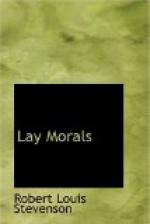outstretched arms, are already sunk to the knees over
the brow of the nearest hill; they have just passed
a milestone with the cipher two; from overhead a great,
piled, summer cumulus, as of a slumberous summer afternoon,
beshadows them: two miles! it might be hundreds.
In dealing with the Land of Beulah the artist lags,
in both parts, miserably behind the text, but in the
distant prospect of the Celestial City more than regains
his own. You will remember when Christian and
Hopeful ‘with desire fell sick.’
’Effect of the Sunbeams’ is the artist’s
title. Against the sky, upon a cliffy mountain,
the radiant temple beams upon them over deep, subjacent
woods; they, behind a mound, as if seeking shelter
from the splendour—one prostrate on his
face, one kneeling, and with hands ecstatically lifted—yearn
with passion after that immortal city. Turn the
page, and we behold them walking by the very shores
of death; Heaven, from this nigher view, has risen
half-way to the zenith, and sheds a wider glory; and
the two pilgrims, dark against that brightness, walk
and sing out of the fulness of their hearts.
No cut more thoroughly illustrates at once the merit
and the weakness of the artist. Each pilgrim
sings with a book in his grasp—a family
Bible at the least for bigness; tomes so recklessly
enormous that our second, impulse is to laughter.
And yet that is not the first thought, nor perhaps
the last. Something in the attitude of the manikins—faces
they have none, they are too small for that—something
in the way they swing these monstrous volumes to their
singing, something perhaps borrowed from the text,
some subtle differentiation from the cut that went
before and the cut that follows after—something,
at least, speaks clearly of a fearful joy, of Heaven
seen from the deathbed, of the horror of the last
passage no less than of the glorious coming home.
There is that in the action of one of them which
always reminds me, with a difference, of that haunting
last glimpse of Thomas Idle, travelling to Tyburn
in the cart. Next come the Shining Ones, wooden
and trivial enough; the pilgrims pass into the river;
the blot already mentioned settles over and obliterates
Christian. In two more cuts we behold them drawing
nearer to the other shore; and then, between two radiant
angels, one of whom points upward, we see them mounting
in new weeds, their former lendings left behind them
on the inky river. More angels meet them; Heaven
is displayed, and if no better, certainly no worse,
than it has been shown by others--a place, at least,
infinitely populous and glorious with light—a
place that haunts solemnly the hearts of children.
And then this symbolic draughtsman once more strikes
into his proper vein. Three cuts conclude the
first part. In the first the gates close, black
against the glory struggling from within. The
second shows us Ignorance—alas! poor Arminian!—hailing,
in a sad twilight, the ferryman Vain-Hope; and in
the third we behold him, bound hand and foot, and
black already with the hue of his eternal fate, carried
high over the mountain-tops of the world by two angels
of the anger of the Lord. ‘Carried to
Another Place,’ the artist enigmatically names
his plate—a terrible design.




